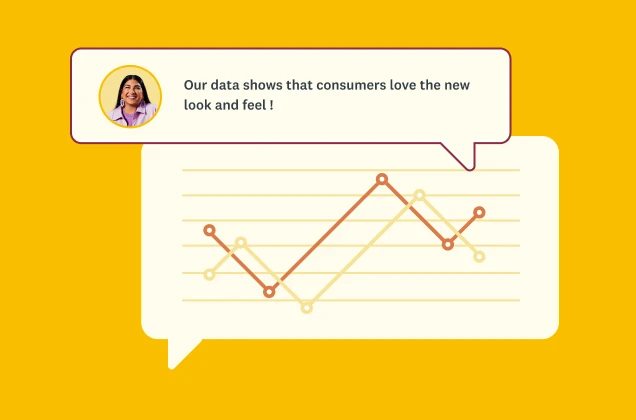How surveys help you create buyer personas
Have you ever received a promotion from a brand that’s entirely irrelevant to your needs and wants? This type of outreach costs the brand in more ways than one: Not only are you unlikely to buy their items, but you lose trust in the brand.
To prevent undesirable and ineffective communication to customers and prospects, organizations of all shapes and sizes develop buyer personas. What are buyer personas? And how can your organization develop them?
We’ll answer each of these questions. That way, next time your team reaches out to your target audience, your messaging will be on point.
Buyer personas overview
Buyer personas are fictional individuals that your organization creates to better understand and imagine who they’re selling to.
When building comprehensive buyer personas, consider including details like the following:
- Their background, both personally and professionally
- The relevant challenges they face
- How your solution or product addresses their challenges
- Their goals and the ways you can help meet them
Once you’ve created buyer personas, you can categorize clients and prospects as particular buyer personas based on their characteristics. If you have hundreds of clients and prospects, you’re more than likely to end up creating at least a few buyer personas, each of whom each have a unique, descriptive name.
Let’s review two buyer personas for a company that sells sneakers at its brick and mortar stores.
1. Buyer persona: “Becky the basketball player”
Background:
- Is a teenager or young adult
- Plays basketball competitively or recreationally
Goals from wearing basketball shoes:
- Jump higher
- Provide ankle protection
Challenges:
- Has a limited budget
- Difficult to find top brands that are affordable
How your business/service solves their challenges:
You offer relatively affordable shoes that promote ankle support and the ability to jump high.
2. Buyer persona: “Rick the casual runner”
Background:
- A middle-aged adult
- Runs a few times a week to stay in shape
- Earns an annual household income of $100k+
Goals from wearing running shoes:
- Keep knees healthy
- Feel relatively comfortable while running
Challenges:
- Unaware of the types of running shoes that are best
- Needs shoes to last for at least a year
How your business/service solves their challenges:
Your in-store employees are trained to observe customers’ running forms. They can then make an educated recommendation for the type of running shoes to buy (which are normally expensive, durable sneakers).
By understanding your two personas, your store can provide the right services and offer the most relevant pairs of shoes to each group.
But how do you learn about your buyer personas in the first place? By sending them a survey.
Why surveys help define your buyer personas
When used correctly, surveys can be valuable tools for uncovering buyer personas.
- If your organization has countless prospects and customers, surveys can be efficient in both resources and time for collecting feedback.
- You don’t need to know every detail. Asking 8-10 questions can provide more than enough information to form your buyer personas.
- Uncovering patterns and trends from online survey responses can be easy with tools like SurveyMonkey Analyze. And by understanding your responses more quickly and comprehensively, your team will improve its persona-creation process.
If you’re set on gathering more comprehensive feedback from a smaller group of people, you can use a focus group or even conduct 1:1 interviews with prospects and customers.
How to write buyer persona surveys
As you work on the survey, consider questions that relate to the respondents’ background, challenges, and goals.
Though the specific questions you want to ask are by and large contextual, we’ll walk you through the process of developing questions using our example of the sneaker store.
Background: This includes their age, level of income, gender etc. As these questions are more personal, you’ll need to build some trust with the respondent before they feel comfortable answering them—in other words, put them near the end of your survey.
Here’s an example of what a background question can look like:
“What’s your age? (Select one answer.)”
- 65 or older
- 55-64 years old
- 45-54 years old
- 35-44 years old
- 25-34 years old
- 21-24 years old
- 20 years old or younger
Challenges: You know that more often than not, it’s because they can’t find the right pair of shoes, struggle to afford the sneakers they want or have a limited budget in the first place. This leads you to ask the following:
“What’s the most common reason that prevents or limits you from buying the sneakers you want? (Select one answer.)”
- Top brands are too expensive (Nike, Adidas, etc.)
- My budget is limited
- Difficult to find the right pair
- Other: please specify
Goals: Looking at your historical transactions and using your experience as a guide, you believe the most popular answers are to jump higher, protect their ankles and help them run faster. Here’s how you can ask the question:
“What are your ultimate goals from the sneakers you buy? (Select all the answers that apply.)”
- Run faster
- Jump higher
- Protect ankles
- Other: please specify
It’s worth noting that you’ll want to include at least one open-ended question on your buyer persona surveys. They’ll give you additional insight into who your personas are and what each of them values.
Pro tip: Remember to consider both your successful customers and target prospects when formulating your buyer personas. Survey both groups using any one of our survey collectors.
Buyer personas are critical to helping your organization identify and understand your different target audiences. Without this understanding, your outreach and engagement efforts will fail to deliver value and instead, prevent the right customers from adopting your products and services. So get to know your buyer personas using surveys. Next time you interact with a customer or prospect, you’ll be glad you did.
Descubre más recursos

Gestor de información sobre percepción
Los gestores de información sobre percepción pueden utilizar este kit de herramientas para ofrecer perspectivas convincentes y procesables.

Conoce las soluciones de SurveyMonkey para bienes y servicios de consumo
El sector de bienes y servicios de consumo (como los CPG, viajes y hospitalidad) confía en las percepciones de SurveyMonkey para moldear el futuro.

Explora las soluciones de SurveyMonkey para minoristas
SurveyMonkey ayuda a los minoristas a responder a las tendencias cambiantes del mercado, desarrollar productos atractivos y crear marcas de prestigio.

Consulta las soluciones de SurveyMonkey para empresas de servicios profesionales
Ve cómo las organizaciones de servicios profesionales utilizan SurveyMonkey para obtener percepciones sobre los clientes y el mercado.